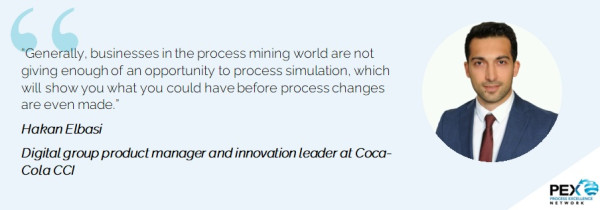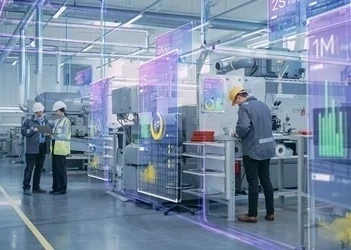Why process mining is the starting point for transformation
Uncover how the pandemic accelerated process mining adoption and why it is the starting point for process transformation efforts
Add bookmark
We respect your privacy, by clicking "Download Your Copy" you agree to having your details passed onto the sponsor who may promote similar products and services related to your area of interest subject to their privacy policy. You have the right to object. In addition, you will receive our e-newsletter, including information on related online learning opportunities. For further information on how we process and monitor your personal data, and information about your privacy and opt-out rights, click here.
Introduction
The rise of hybrid and remote-work models has altered the way process excellence (PEX) professionals and managers are able to evaluate how organizational processes play out in reality and assess their efficacy.
Before the Covid-19 pandemic, PEX practitioners could witness the functioning of organizational processes first hand, as they would be present in the place of work. With many organizations across the globe switching to remote or hybrid-work models, PEX practitioners have to find effective ways of ensuring processes run smoothly remotely.
Process mining offers companies visibility on how their processes run. It utilizes data from event logs to produce digital representations of processes, allowing practitioners to identify bottlenecks and uncover opportunities for automation.
The trajectory for process mining software investment is clear, with a 2021 report from Grand View Research predicting that the market size for process mining software will expand at a compound annual growth rate of 50.1 percent between 2021 and 2028, from its 2020 valuation of US$322mn.
This PEX Network report evaluates why and how the pandemic has accelerated process mining adoption, before detailing the ways in which the technology can be integrated with intelligent automation (IA) to boost transformation efforts.
Featuring expert insights from Coca-Cola CCI, GSK, Mavim and Minit, the report also dives into the key trends impacting process mining adoption and its implementation over the next 12 months.

How the pandemic led to increased investment in process mining solutions
The uncertainty that arose at the outset of the pandemic caused confusion across the globe and put many organizations under serious pressure to develop a plan of action that ensured business continuity despite significant disruption.
Process mining helped pharmaceutical company GSK navigate the new way of working and the business saw a rapid adoption of the technology from employees due to its ease of working, after they understood its purpose.
Ajay Jayendran, senior transformation manager, process mining and analytics at the company explains: “With the new way of working and process mining in place, people were excited to see that, once connected, it quickly visualizes an entire process and shows its deviations. Its adoption was quicker than expected despite the initial hiccups that were observed due to people being hesitant to see what it was and understand its purpose.”
Businesses sought to understand how the pandemic would play out and what its impact would be, and this is where process mining made a difference, according to James Dening, CEO at Minit.
“There were certainly a large number of companies that found themselves under the pressure of figuring out how to optimize their processes, how to reduce costs and how to retain their customers in some cases,” recounts Dening. “There was definitely an element of damage limitation for many companies and we found there were not many technologies that could deliver those benefits without being expensive and long-term to wield.”
Process mining filled a role that was needed at the outset of the pandemic and its ability to deliver positive return on investment (ROI) in a short time frame was critical. Dening explains the need to act fast to avoid falling behind more proactive competition resulted in rapid uptake of process mining solutions.
Managing remote teams with process mining
Now that many organizations are implementing remote or hybrid-work models, process mining addresses the need to have enhanced visibility over how disparate teams are working to help them run as smoothly as possible. According to Hakan Elbasi, digital group product manager and innovation leader at Coca-Cola CCI, process mining is ideal for meeting these needs.
“With many people working from home, KPIs have to be determined in order to measure their success,” explains Elbasi. “With process mining [analyzing event logs] you can see exactly how your team is working and instantly identify bottlenecks and determine KPIs, allowing you to create some triggering actions [to alleviate these bottlenecks].”
With managers unable to observe the functioning of organizational processes in-office, the ability to drill down into organizational data through event logs is key. This allows managers to run teams at full efficiency, uncover opportunities for new hires and understand how to adjust processes and procedures to gain efficiency.
Related interview: data/process mining interview
The next section of this report looks into the ways that process mining integrates with IA and other digital technologies to aid transformation efforts.
Integrating process mining with other technologies to boost transformation efforts
When it comes to business transformation efforts, automation and process mining are both often discussed as effective methods for overhauling processes and enhancing efficiency. Process mining allows companies to have a greater focus on data analytics, which is the top solution in which organizations are investing in according to PEX Report 2022.
According to Minit’s Dening, process mining can be considered a precursor to any process improvement effort, which includes attempts to automate processes or parts of processes.
“There are lots of options to optimize and automate processes that include business process outsourcing, artificial intelligence, robotic process automation, low-code and no-code,” he says. “All of these have one thing in common – they would all benefit from understanding how well the processes work in the first place.”
Process mining helps organizations understand where to focus automation efforts by understanding how processes work, where the bottlenecks are and which steps would benefit most from the application of automated bots.
“I see process mining as the searchlight that tells you how well a process is working and what you can do to improve automation attempts or to reduce cost,” Dening says.
GSK’s Jayendran believes that current advances in the field of process mining allow it to have the capability todo much more. Advanced technologies that are available on the market can identify high-priority areas for automation that do not require input from a user.
“I would say it is a perfect scenario where process mining is used along with automation and they are not kept in silos,” explains Jayendran. “Otherwise we will always create opportunities, but there will be no actionable outcome.”
Another way to get more out of process mining is to combine it with process simulation, which Elbasi believes organizations are not giving enough attention to.
“Generally, businesses in the process mining world are not giving enough of an opportunity to process simulation, which will show you what you could have before process changes are even made,” Elbasi says.
The next section of this report looks into the key trends shaping the evolution of the process mining field and offers some predictions for what to expect over the next 12 months.
Top 2022 process mining trends
As we continue to see organizations adopting and utilizing process mining, we will likely see best practices and key themes advancing as the efficacy of new technologies and approaches are realized. As such, the industry experts featured in this report have offered their predictions for how the field of process mining will evolve over the next 12 months.
Process mining adoption will continue to accelerate
The consistent increase in adoption levels for process mining that we have seen over the last 12 months is a trend which Minit’s Dening predicts will only accelerate in 2022.
“The analysts say that the market is going to be somewhere between 2.5 to three times the size it is now and I think for once they are possibly right,” remarks Dening. “I am seeing a real acceleration in the market of people implementing process mining across the organization. People know what it is, they recognize its value and they want to get involved.”
Process mining champions help drive a culture of process improvement
Process mining champions are individuals within an organization who act as an ambassador for process improvement. They are knowledgeable on the capabilities and best practices for process mining and help to ensure everyone understands how the technology can help them.
GSK’s Jayendran believes that over the next 12 months process mining champions will become more common and organizations will begin to enjoy the benefits that they can offer.
“It is important to create process mining champions for organizational processes, who can understand the capabilities of process mining and work within organizational processes,” Jayendran advises. “When you complete the entire end-to-end process champion workshop, you need to reward the people who have made it work so that they feel recognized – if we see more of this, we will begin to witness a shift in the culture of businesses as they become more focused on process improvement.”
Related interview: Building the three pillars of corporate culture
This report has showed that the altered way of working brought upon by the Covid-19 pandemic has significantly accelerated the adoption of process mining technologies. Process mining offered a solution to some major challenges that include a lack of visibility over processes and teams’ productivity and, as such, many organizations flocked to implement it.
Process mining also offers an opportunity to enhance automation efforts by identifying opportunities, with platforms even having the ability to apply these automations without user input.
The advantages of process mining that have been discussed in this report make it unsurprising that we can expect either an increase in process mining adoption or implementation over the next 12 months. Those who implement process mining or augment it with simulation have an opportunity to attain great levels of process visibility and will leave behind those who do not.
‘What-if analysis’ in action
What is it?
A ‘what-if analysis’ measures how changes in a set of independent variables impact a set of dependent variables. The strength of simulation is that it allows practitioners to “look into the future” under certain assumptions.
With this capability, it becomes easy to validate certain statements, such as “The duration time of our production process in Japan is expected to decrease by 21 percent if we automate the second production order approval”, and “When we increase the number of resources in our warehouse in Nigeria by 30 percent, we can increase our overall delivery volumes by 80 percent without affecting our delivery reliability”.
It is hard to substantiate the effects of intended changes to any part of your process or organization upfront. Therefore, many decisions are still made based on gut instinct. The statistics about large transformations indicate a staggering failure rate of 70 percent.
This is because companies lack structure and insight into all their organizational elements and their interrelation. Even companies that do have their processes and other organizational elements documented still lack insight into their actual performance.
After identifying actual process performance and improvement potential, however, it is still hard to predict what the actual impact will be in the organization, since only historical data is available.
This makes it difficult to predict the impact of specific improvements. Practitioners must ask themselves a number of questions. What is the actual impact of automating specific transactions? What will happen to the rest of the process? Will this cause a bottleneck to shift to another point in the process? Compliance is important, but what will the overall effect be on the duration of the process when these approval steps are added?
To help simulate and predict the impact of potential changes to their processes, a company made use of the process simulation functionality, or as we prefer to call it ‘what-if analysis’.
Based on the historical data used in process mining and the historical distribution of transactions and mathematical algorithms in Mavim’s process mining platform, they were able to simulate the effects and the ROI of the proposed automation of specific transactions and other proposed alterations to their processes.
This led to the following conclusions:
- The proposed automation of approvals with consistent volumes in the purchase-to-pay process would not lead to an overall decrease in process duration due to a bottleneck shift toward the booking of the actual orders.
- Increasing the capacity of the people booking orders by 20 percent would lead to a decrease in duration of the purchase-to-pay process of 6.5 days on average and an annual cost benefit of €800,000 when average volumes do not change.
- Automating the transactions around the booking of the orders would lead to a volume increase in overall processing capacity of 125 percent, while leading to a decrease in duration by another seven to eight days and an annual cost benefit of €1.4mn.
Value for management
The company’s leadership was able to show the authorities that they were in control of their processes, ensuring compliance to regulations and standards. This significantly decreased their exposure to potential fines or reputational damage.
Value for workforce
Employees were able to find, learn and apply essential knowledge about regulations and standards in their day-to-day operations. Due to the automation of the most tedious repetitive tasks that were sensitive to human error, employees’ time was freed up to spend on more challenging and value-adding activities.
This report was initially published on December 23, 2021.
Do you see the trends mentioned happening across organizations? Let us know by leaving a comment below.








![Mine, design and improve business processes [E-BOOK]](https://eco-cdn.iqpc.com/eco/images/channel_content/images/e-book.webp)
















